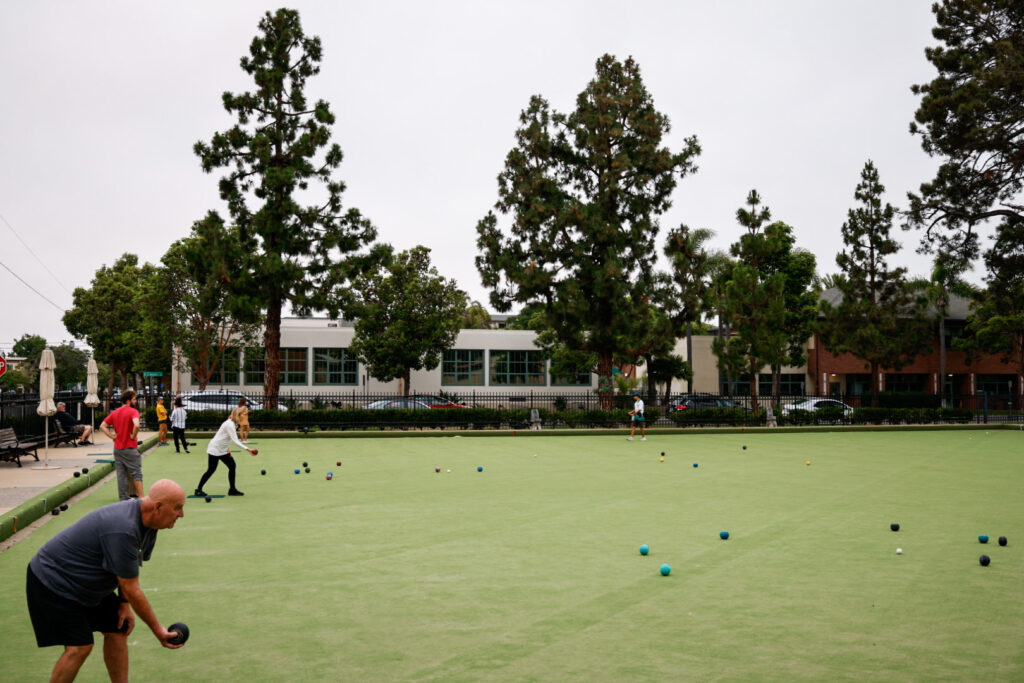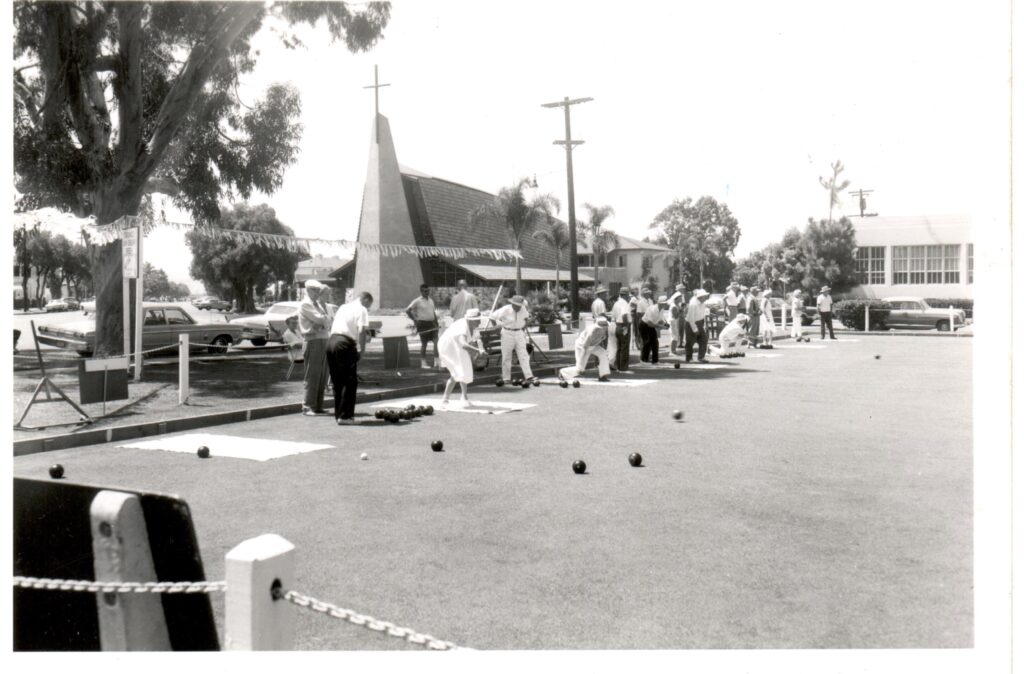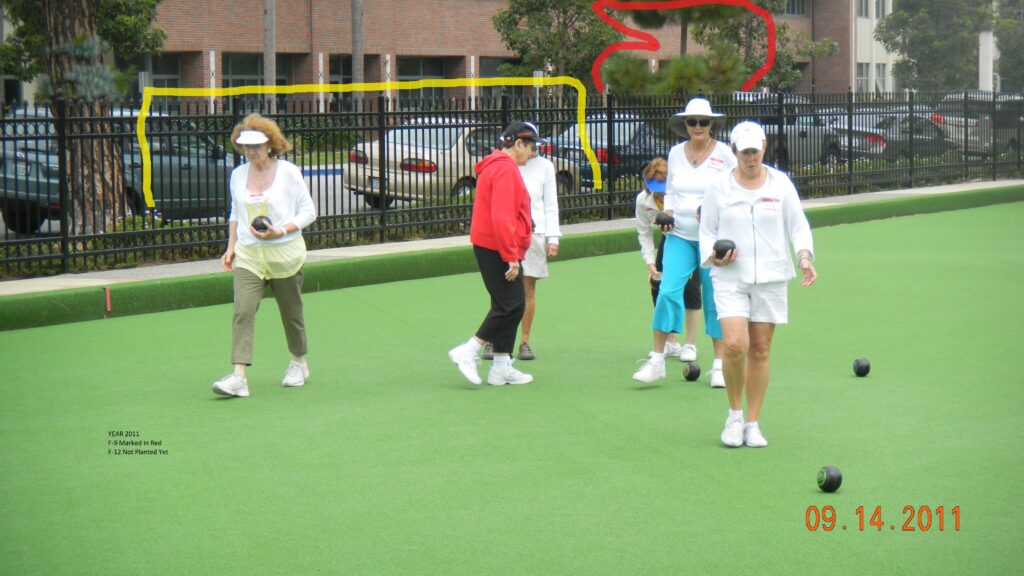
A decision to remove trees adjacent to the John D. Spreckels Center’s lawn bowling green has come under fire, and the Coronado City Council will revisit the matter at its Aug. 15 meeting.
The trees – four Canary Island pines and one Torrey pine – line D Avenue. Their roots host puffball fungus, which has created more than 20 mounds that render the artificial turf lawn bowling green unplayable. Council voted on July 18 to remove the trees and install a root barrier after attempts to mitigate using fungicide were unsuccessful.
On one side, the Coronado Lawn Bowling Club says the service they offer the community provides enough value that alternative landscaping should be considered. On the other, residents say removing the large trees does a disservice to the environment and the city.
Council member Casey Tanaka requested the matter be reconsidered after speaking with community members.
His request only covers the four Canary Island pines; because he voted against the removal of the Torrey pine during July’s meeting, he cannot make a motion to reconsider.
“It became clear to me that the public was broadly opposed to the removal of these four, mature trees,” Tanaka said. “Whenever I attempted to explain our reasoning for the removal of the four trees, I was met with frustration and disbelief. [. . .] I was noticing a uniform degree of dissatisfaction with my reasoning. Some were even insinuating that there was something underhanded going on. Thus, it became clear to me that we, as a council, should reconsider our decision to give people more time to weigh in, and potentially move to an alternate solution that the public would be more supportive of.”
But, he said, he appreciates the role the Coronado Lawn Bowling Club plays in Coronado and the community it’s built for all ages.
“I will continue to try to balance the needs of the lawn bowling green with the views of the community as a whole,” Tanaka said. “I will seek solutions that will hopefully be fair to the different interest groups involved in this discussion.”
The Coronado Lawn Bowling Club was established in 1935. The club serves as custodians of the bowling green under a contract with the city. Its volunteer membership also provides free lessons to the public.
However, the city still pays for major projects related to the club’s green, and has slated $1.4 million to replace its turf. The green was originally a grass field, and was replaced with artificial turf in 2010. The turf has a 10-year life expectancy.
Critics of the plan say protecting the environment is more important than preserving the playing field. Although city staff first recommended the trees be removed in February 2021, the project’s description — “lawn bowling green replacement project” — did not overtly mention removing trees, which some say allowed the matter to move through bureaucracy unnoticed by objecting residents.
Tanaka posted updates on his motion to reconsider council’s decision to remove the canary pines on Facebook posts that garnered hundreds of comments, most in objection to removing the trees.
“I am quite convinced that if we were to put this to a vote in our community, the public would defer to the lives of those four trees over the fungal ball problem under the lawn bowling green,” Tanaka said. “I don’t think I was aware of that fact on July 18, but I was becoming aware of that fact by July 25, hence my submittal of a motion to reconsider.”
But not everyone is convinced the worth of the trees outweighs the worth of the lawn bowling green.
“A critical part of this discussion is that everyone is saying these are valuable and mature trees,” said Berie Grobe, immediate past president of the Coronado Lawn Bowling Club. “They’re not mature trees, and they’re not as old as some of the lawn bowling players.”

In photos taken in the 1960s provided by Grobe, the trees are absent, and in a 2011 photo, one of the Canary Island pines slated for removal is small, while another is not yet visible. Canary Island pines are fast-growing, and can increase in height by more than two feet annually.
The club operates in lieu of city staff operating the green, as they do for the city’s tennis and golf facilities, Grobe said.
“Thirteen people run ragged all year, because we give several hundred lessons all year for people who want to see if they like the sport,” she said.

Grobe said the problem would persist even if the city reverted to grass, because the fungus creates hard mushrooms that compromise the field.
To some, it may seem like it’s just a game, but the real value lawn bowling offers, Grobe said, is in the community and activity it offers to Coronadans, especially those growing older.
“If people stay home and isolated and aren’t interacting with other people, it causes all sorts of diseases,” she said. “Lawn bowling pulls them out not only socially, but it also gets them outdoors, which is critical. We’ve had people get Alzheimer’s disease or dementia, and we were able to keep people on the green that would have been bedridden otherwise. One couldn’t talk, but he could bowl.”
Other members turn to lawn bowling after tennis or other outdoor sports become too difficult on their joints, Grobe said.
“We all love the environment,” she said. “But when I see someone valuing a tree over a 97-year-old man, something is amiss.”
Coronado boasts more than 9,000 trees on public land, and has been designated a Tree City USA every year since 1984.
Those who oppose the trees’ removal say the decades it would take for any replacement trees to reach the height of the current trees is not worth protecting an artificial turf. Large trees like the ones in question provide shade, absorb more carbon dioxide annually, and are a crucial part of habitats for local animals, birds, and insects.
City Council will revisit the matter at its next meeting at 4 pm on Aug. 15. Learn more about the turf replacement project here.




